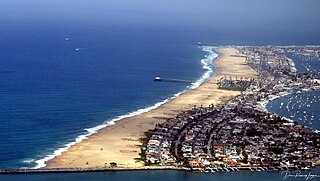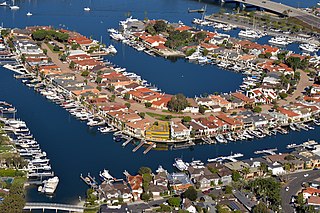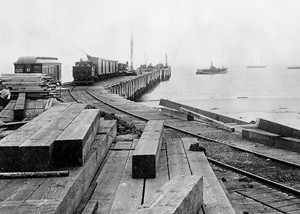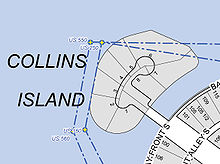
Newport Beach is a coastal city of about 85,000 in southern Orange County, California, United States. Newport Beach is known for swimming and sandy beaches. Newport Harbor once supported maritime industries; however, today it is used mostly for recreation. Balboa Island draws visitors with a waterfront path and easy access from the ferry to the shops and restaurants.

Balboa Island is a harborside community in Newport Beach, California, accessible to the public via bridge, ferry and several public docks. The community is surrounded by a paved concrete boardwalk open to pedestrian traffic, designated as a public walking trail by the city.

The Balboa Peninsula is a neighborhood of the city of Newport Beach, Orange County, California. It is named after Spanish explorer Vasco Núñez de Balboa, the first European to sight the Pacific from the Americas. Balboa is primarily residential with some commercial areas.

The Orange Coast is the string of cities and neighborhoods fronting the Pacific Coast in Orange County, California. From northwest to southeast, these cities are Seal Beach, Huntington Beach, Newport Beach, Laguna Beach, Dana Point and San Clemente. There are also two small unincorporated areas, a portion of Crystal Cove State Park between Newport Beach and Laguna Beach and Emerald Bay, a gated community located between two neighborhoods of Laguna Beach.

Newport Center is a business, shopping, and entertainment district located on a high bluff overlooking Newport Harbor in Newport Beach, California, centered around the Fashion Island regional shopping mall. It was created in the early 1960s as part of William Pereira's master plan for the Irvine Ranch. Newport Center was created as the unofficial "downtown" of the Irvine Ranch, which at the time extended all the way down to Pacific Coast Highway.

The Balboa Pavilion in Newport Beach, Orange County, California, is a California Historical Landmark and a National Historic Place. Established on July 1, 1906, the Balboa Pavilion played a prominent role in the development of Newport Beach by attracting real estate buyers to an area formerly designated as "swamp and overflow" land.

The Balboa Pier is one of two piers in the city of Newport Beach, Orange County, California. The other ocean pier on the Balboa Peninsula is the Newport Pier.

The Balboa Island Car Ferry is a ferry service in Newport Beach, California.

The recorded history of the Newport Beach, California region began when the area was first explored by Europeans in the 1500s. Prior to that time, Native Americans such as the Tongva and Juaneño/Luiseño people had been living in the area for thousands of years. Explorer Juan Rodriguez Cabrillo mapped the coastline in 1542, but it was 200 years before Europeans settled the area. In 1769, Newport was a small portion of the land grant of Don José Antonio Yorba I, first under Spanish and then Mexican rule. After the Civil War, the land was developed by American settlers: for ranching by James Irvine and for shipping by James McFadden. A small settlement was built around McFaddens’ Wharf and it became the largest business of Orange County, California. Following the opening of the San Pedro Harbor in Los Angeles in 1899, the commercial shipping industry in Newport declined. Newport Beach developed into a tourist and recreational boating community. in August 1906, Newport Beach became incorporated as a city.

The Newport Pier is one of two municipal piers in the city of Newport Beach, California. The pier replaced the McFadden Wharf (1888-1939) and the site is registered as California Historical Landmark number 794. It is 1,032 feet long. The other ocean pier on the Balboa Peninsula is the Balboa Pier.

The Balboa Bay Resort is a 160-room resort hotel in Newport Beach, California, United States on 15 acres (6.1 ha). The facility was founded in 1948 as the Balboa Bay Club, a private yacht club. The Balboa Bay Club includes a 130-slip marina, private beach, waterfront pools, private restaurant, a spa and fitness center, and 145 apartments on the Newport Beach Harbor waterfront on the Pacific Coast Highway.

Lido Isle is a man-made island located in the harbor of Newport Beach, California. Surrounded by the city, Lido Isle was incorporated as part of Newport Beach in 1906. At that time it was part sandbar and part mudflat. There are no commercial facilities on the island other than a small snack bar open in the summer, and its only link to the city is a small bridge. The man-made island is solely residential with approximately 1,800 people living on the island.
Beek's Place is a location in North Eastern Orange County California, elevation 2,820 ft (860 m).

Linda Isle is a part of the Lower Bay of Newport Beach, California. In 1954, Linda Isle became the last island to be incorporated into the city of Newport Beach, and it was in this period that the entire city, including the islands, began to change from a resort to a residential community. Linda Island is laid out in the shape of a horseshoe, and each home has its own dock. The island is not accessible to the public.

Bay Island is a small island located halfway down Balboa Peninsula in Newport Beach, California. It is the only island in the Newport Beach harbor islands that does not allow car traffic. The island is accessible via a small bridge that will only accommodate golf carts. The island is not accessible to the public by land, though public access to its beaches is protected by the California Constitution. It has 23 residences, a botanical garden, courtyard garden, tennis court, and several beaches.

Crystal Cove State Marine Conservation Area (SMCA) is one of a cluster of four adjoining marine protected areas that extend offshore of Newport Beach in Orange County on California’s south coast. The SMCA covers 3.45 square miles of near shore waters. Crystal Cove protects marine life by limiting the removal of marine wildlife from within its borders, including tide pools. Take of all living marine resources is prohibited except: recreational take of finfish by hook-and-line or by spearfishing, and lobster and sea urchin is allowed. Commercial take of coastal pelagic species by round haul net, spiny lobster by trap, and sea urchin is allowed.
Upper Newport Bay State Marine Conservation Area (SMCA) is a marine protected area in Newport Bay in Orange County and the South Coast region of Southern California. It extends inland/northeast from the Pacific Coast Highway crossing of the bay, within the city of Newport Beach.

Newport Bay, in Southern California, United States, is the lower bay formed along the coast below the Upper Newport Bay, after the end of the Pleistocene. It was formed by sand, brought by ocean currents from the Santa Ana River and other rivers to the north, which constructed an offshore beach, now called the Balboa Peninsula. The bay was named by the Spanish Bolsa de Gengar in the 18th century, to refer to the nearby Tongva and Acjachemen village of Genga. An estuary of the Santa Ana River in the late 19th century, it was dredged to form Newport Harbor, the harbor of Newport Beach.
The Rendezvous Ballroom was a large dance hall built in 1928, located on the beach of Balboa Peninsula in Orange County, Southern California, between Los Angeles and San Diego. The 1920s were the beginning of the heyday of public dancing to the music of popular bands and orchestras, and large ballrooms were built in most urban areas, and even on Catalina Island, 26 miles off the California coast.

The place of McFadden Wharf was designated a California Historic Landmark (No.794) on July 3, 1964.


















